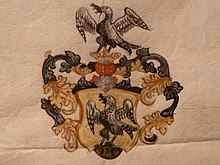Ebinger from the castle
The Ebinger (later Ebinger von der Burg ) were among the oldest families in Swabia . Their headquarters of the same name in Ebingen (today a district of Albstadt in the Zollernalb district in Baden-Württemberg ) is already mentioned in documents from the year 793. The Ebinger family belonged to the Swabian nobility .
Henricus de Ebingen (* 1138) appears in a family tree as the first known ancestor of the Ebinger family, who is among the oldest founders of the Zwiefalten monastery up to 1138 , in that he owned an estate in Romanisbach - later Rommelsbach (?) Im Tübingen district - donated to this monastery. In 1304, Count Eberhard von Nellenburg confirmed a donation made by Johann Friedrich and Burkhard von Ebingen to the Salem monastery for a " anniversary " of their father Henricus de Ebingen (* 1278). Hans der Ebinger, citizen of Mengen 1366. In 1497 Hans de Ebingen sells his estate Mommenwinkel near Ravensburg to this city. In 1549 Eitel Hanns de Ebingen, bailiff of the county of Heiligenberg , was enfeoffed by Count Friedrich von Fürstenberg with the estate "Burg zu Limpach auf dem Homberg" near Heiligenberg . Since then, the family has been called Ebinger von der Burg. Emperor Maximilian II granted them the title of imperial knight with this title in 1572 . Andreas Ebinger († 1568) was Count's Fürstenberg secretary and land clerk in Heiligenberg. In the 14th and 15th centuries, descendants of the Ebingen family made, among others, daughters of the respected noble families of those von Lupfen , von Jungingen , von Hertenstein , von Heudorf or von Reischach their wives.

The Ebinger from the castle acquired significant land position in the Hegau and neighboring Thurgau , so in 1659 the patio Bachtobel the Ottenberg on the southern slope in Weinfelden (until 1784). As owners of several imperial dominions in the imperial knighthood of the canton of Hegau , they were highly regarded as councilors of knights. From 1619 to 1785 the Ebinger von der Burg family ruled Schlatt Castle under crows . In 1671 they acquired Neuhewen Castle, which was destroyed by Bavarian troops in the Thirty Years War (1639) and is now only in ruins . From 1672 to 1780 they were also the landlords of Steißlingen . At the end of the 17th century (1698) to 1731 the Ebingen family were also the landlords of Mühlingen . At that time, the sex was in its prime, it was family connected with the most respected families (such as those of Freyberg , von Rosenberg , von Roggenbach ) in Swabia. Family members are distinguished by rich donations and foundations to churches and monasteries, many dedicated themselves to the service in the church and some held higher church offices (Johann Baptist Ebinger von der Burg, * 1739, Knight of Malta and Canon in Constance , Johann Franz Philipp Ebinger von der Burg, * 1746, Canon of Kempten ). With the death of Conrad Freiherr Ebinger von der Burg (* 1747, † 1808), married to Maria Anna, née Baroness von Hornstein - Göffingen (* 1759, † 1819), the family died out due to a lack of male descendants.

His older daughter Maria Anna Ebinger von der Burg (* 1771) married Joseph von Laßberg in 1795 . His younger daughter Maria Fridolina Freiin Ebinger von der Burg (* 1786) married (after his simultaneous adoption by Conrad Ebinger von der Burg) in 1806 Friedrich Franz Freiherr von Krafft called von Festenberg auf Frohnberg (* 1784 in Stockach , † 1813 in Immendingen ), Landlord of Zizenhausen . With royal Württemberg approval for the name connection (decree of March 7, 1808), he was now called Baron von Krafft-Ebing .
coat of arms
The coat of arms (Wappenstein: Riedlingen anno 1283), a vulture standing in a golden shield , ready to fly on a green three-mountain , holding a natural mouse in its beak; the helmet with a black and gold helmet cover , as a crest a standing vulture ready to fly with a mouse in its beak.

literature
- Upper Baden Gender Book, Ed. Badische Historische Kommission, J. Kindler von Knobloch, Volume I, Heidelberg, Carl Winter's Universitätsbuchhandlung, 1898, pp. 274 ff.
- Württemberg book of nobility and arms, written by Otto v. Alberti, Verlag W. Kohlhammer, Stuttgart 1889–1898, Volume I, p. 146
Web links
- Thomas Holenstein: Bachtobel. In: Historical Lexicon of Switzerland .
- Holy Cross Chapel in Steißlingen
